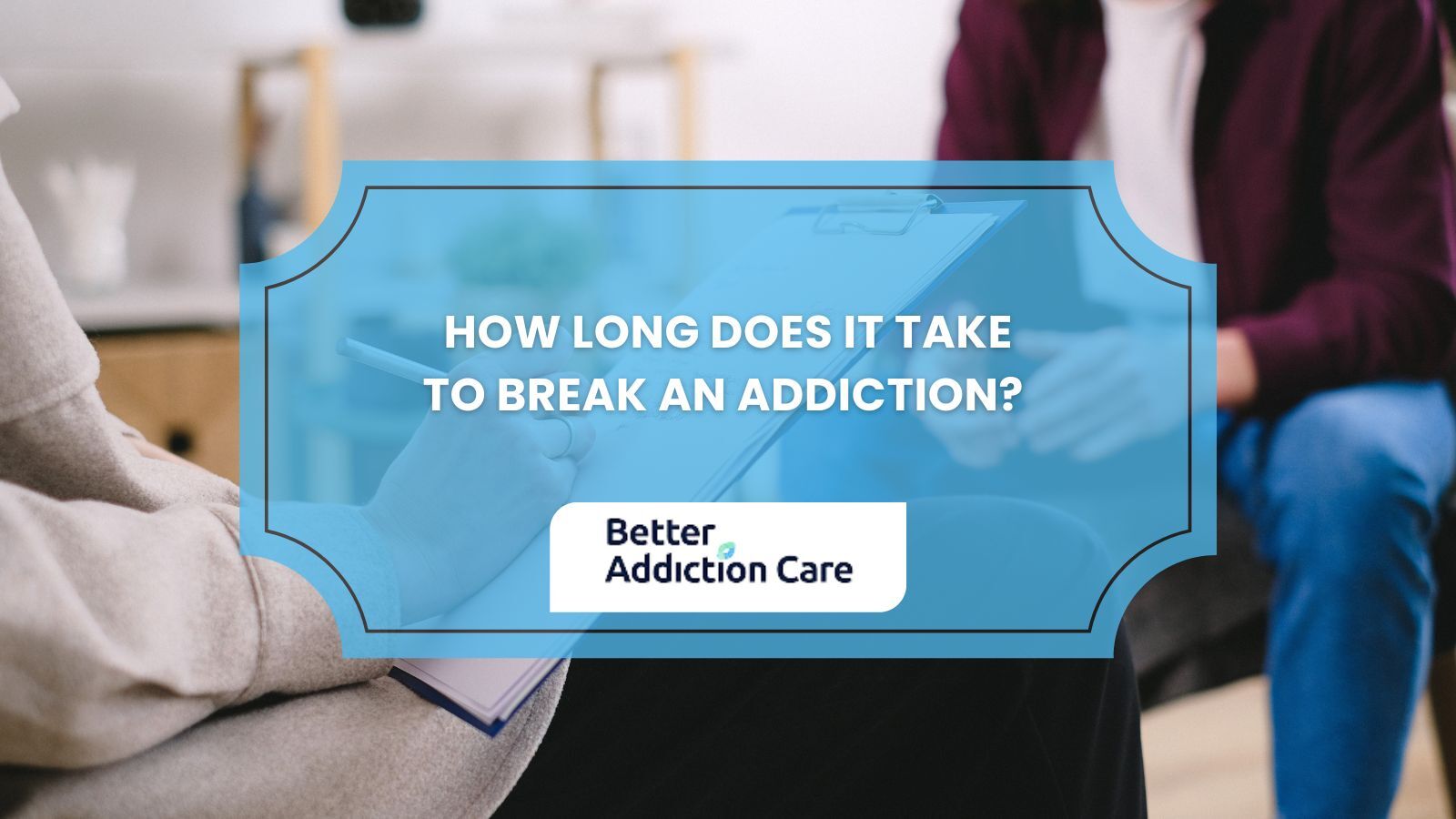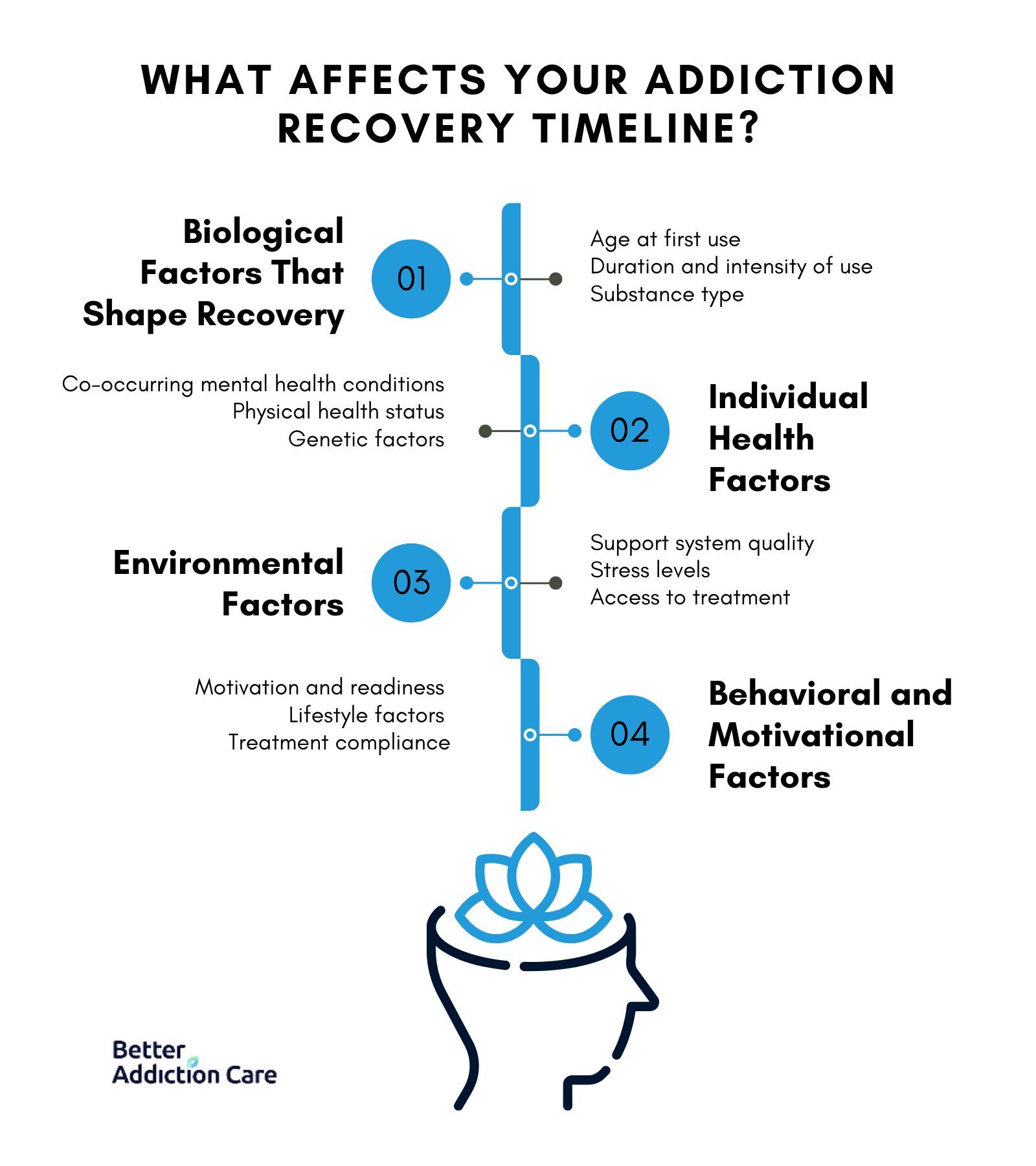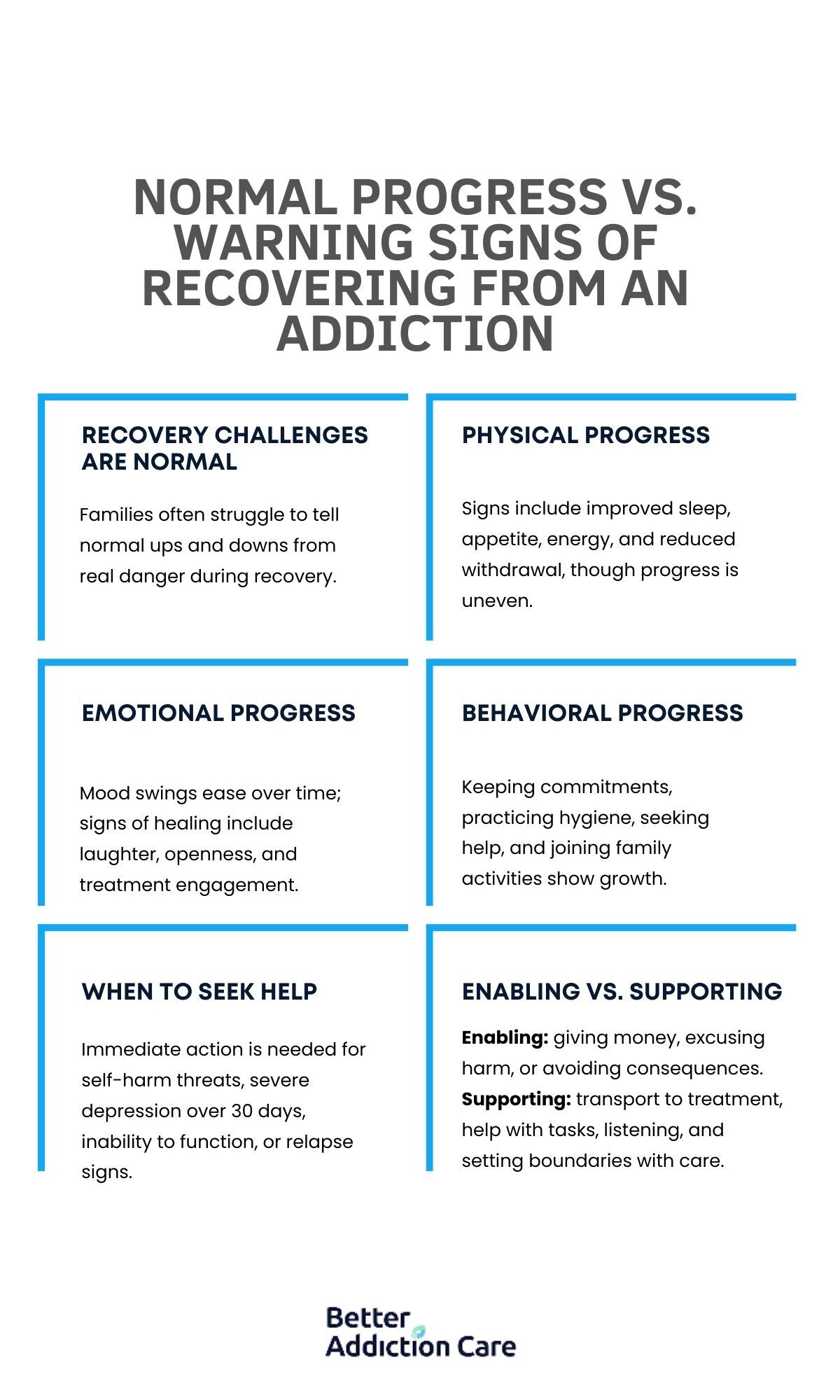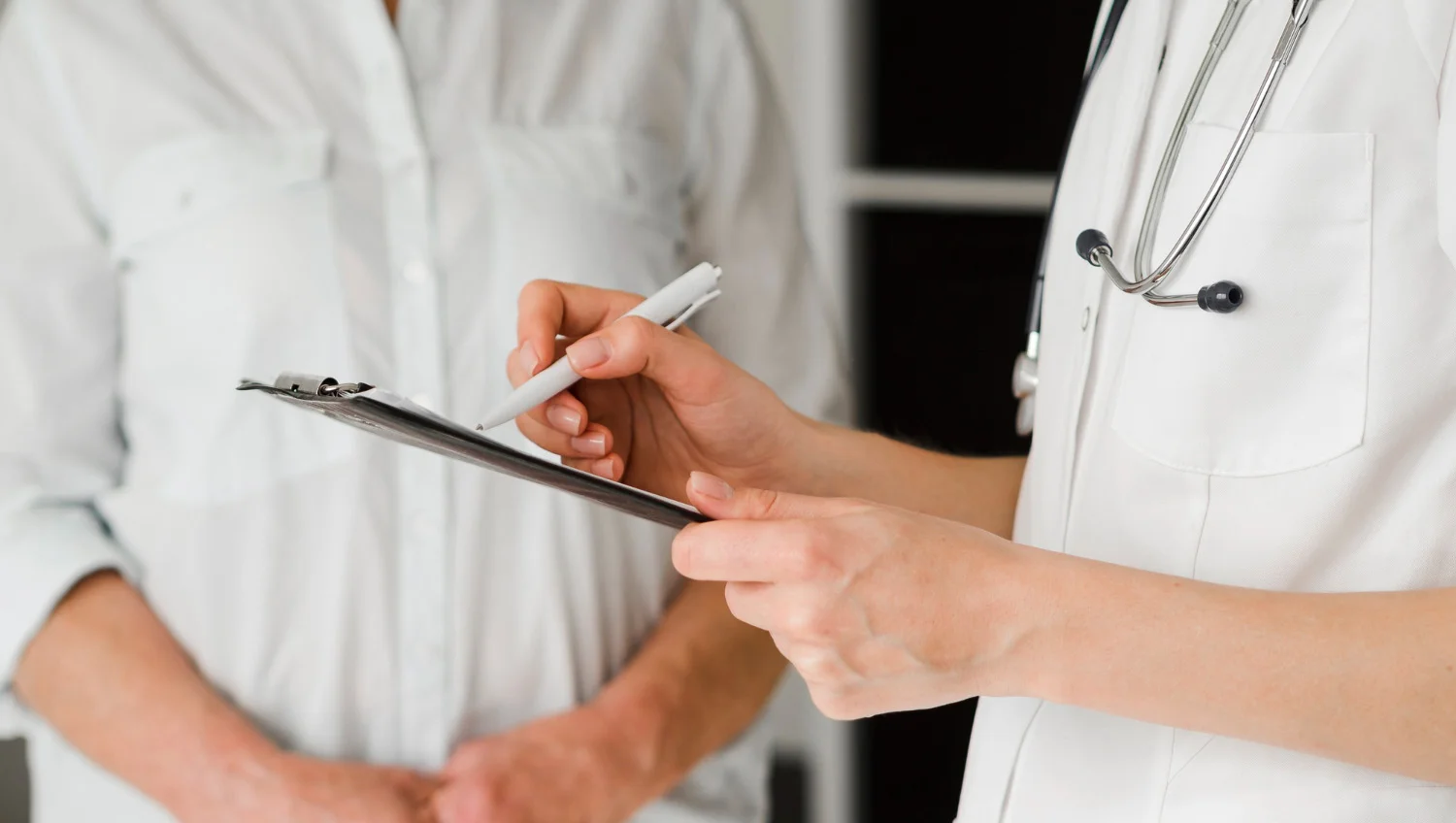How Long Does It Take to Break an Addiction?
Breaking addiction takes 90 days to 2+ years for most people, with recovery happening in three distinct phases: physical detox (3-30 days), psychological healing (3-6 months), and behavioral reconstruction (6-24 months).

Key Takeaways:
-
Breaking addiction takes 90 days to 2+ years, not 21 days: Physical withdrawal may end in weeks, but genuine freedom from addiction, where cravings become manageable and healthy behaviors feel natural, typically requires three distinct phases: physical detox (3-30 days), psychological healing (3-6 months), and behavioral reconstruction (6-24 months).
-
Relapse is common and doesn't mean starting over: With relapse rates of 40-60% (similar to other chronic diseases), setbacks are often part of the recovery process rather than failures. Each attempt builds knowledge and coping skills that strengthen future recovery efforts.
-
Both individuals and families need different support strategies at different stages: Early recovery requires crisis management and medical support, while later stages focus on rebuilding relationships and developing life skills. Understanding these phases helps set realistic expectations and provide appropriate help.
A 2020 study by Thomas F. Martinelli et al., published in Drugs: Education, Prevention and Policy, supports the phased model of addiction recovery. It defines early recovery as less than 1 year, sustained recovery as 1–5 years, and stable recovery as more than 5 years. The researchers found that individuals in later stages had lower odds of housing problems, crime involvement, and hard drug use, and higher odds of employment or education participation.
Breaking free from addiction isn't a quick, straight path; it's a personal journey filled with challenges, setbacks, and healing that takes time.
Whether you're fighting this battle yourself or supporting a loved one, understanding that recovery is a gradual process fueled by patience, support, and hope can make all the difference.
But behind those numbers lies a deeper truth: your timeline isn't about being "strong enough" or "trying hard enough." It's about giving your brain, body, and spirit the time they need to heal from a disease that affects every part of who you are.
This timeline is vastly different from the popular "21-day habit" myth, as addiction is a complex brain disease requiring comprehensive treatment and long-term support.
What does the emotional timeline look like when breaking an addiction?
During addiction recovery, patients move through a wave of emotions, feeling impossible, short relief, followed by anxiety, irritability, grief, and eventually growing confidence and emotional stability.
Listed below is an emotional timeline for breaking an addiction.
Month 1: "Everything Feels Impossible"
What's happening in your brain: Your Brain’s neurochemistry is in chaos. Your dopamine system, hijacked by substances, needs dopamine receptor recovery and learning to function normally again.
What you'll feel:
-
Intense cravings that feel like physical hunger
-
Mood swings that switch from depression to anxiety without warning
-
Sleep that's either impossible or the only escape
-
Feeling like you're grieving the loss of your "best friend" (the substance)
For families: This is the scariest time. Your loved one may seem like a stranger, irritable, emotional, and physically uncomfortable. This is a withdrawal, not who they are.
What helps: Medical supervision, basic self-care, and remembering that feeling terrible is a sign of healing.
Month 2-3: "Some Days Are Good, Some Days Are Terrible"
What's happening: Your brain rewiring is starting to produce its feel-good chemicals again, but inconsistently. You're learning to cope with emotions you've been numbing.
What you'll feel:
-
Days where you think "I've got this," followed by days of despair
-
Emotional intensity that feels overwhelming
-
Frustration that progress isn't linear
-
Grief for the time and relationships addiction costs you
For families: This is when you might think "they're getting better," only to see them struggle again. This back-and-forth is completely normal.
What helps: Professional addiction therapy, support groups, and celebrating small victories.
Month 3-6: "I Can See Glimpses of Who I Used to Be"
What's happening: Your prefrontal cortex (decision-making center) is healing. You're starting to think more clearly and feel more stable.
What you'll feel:
-
Cravings that are less frequent but can still blindside you
-
Slowly returning interest in activities you used to enjoy
-
Anxiety about social situations and rebuilding relationships
-
Hope mixed with fear of letting people down again
For families: You'll start seeing the person you remember, but they may still have bad days. Don't rush them back to "normal."
What helps: Developing healthy routines, addressing underlying trauma, and learning new coping skills.
Month 6-12: "I'm Starting to Feel Like Myself Again"
What's happening: New neural pathways are strengthening. You're building a life that doesn't revolve around substances.
What you'll feel:
-
Confidence in your ability to handle challenges sober
-
Genuine enjoyment of activities and relationships
-
Occasional waves of sadness or nostalgia for your using days
-
Pride in how far you've come
For families: This is when you can start to relax a bit, but stay supportive. Recovery is still fragile.
What helps: Continued addiction therapy, meaningful activities, and building a sober support network.
Year 1-2: "I'm Building a Life I Want"
What's happening: Recovery becomes less about not using and more about living fully. You're addressing the underlying issues that led to addiction.
What you'll feel:
-
A sense of purpose and direction
-
Ability to handle stress without substances
-
Gratitude for your recovery journey
-
Occasional triggers, but with tools to manage them
For families: You can start to trust the process, but remember that recovery is lifelong.
What helps: Ongoing support, giving back to others in recovery, and continuing personal growth.
Do habits take 21 days to break?
No, the idea that habits take 21 days to break is a popular myth, originally stemming from observations by plastic surgeon Dr. Maxwell Maltz in the 1960s. He noticed that his patients took about three weeks to adjust to changes in appearance, but this was about habituation, not habit-breaking.
Scientific research paints a more complex picture. A 2009 study published in the European Journal of Social Psychology found that forming a new habit took anywhere from 18 to 254 days, with an average of 66 days for a behavior to become automatic3. Breaking a habit often takes just as long, if not longer, depending on factors like how ingrained the habit is, emotional triggers, and environmental cues.
The popular belief that habits take 21 days to break comes from observations of plastic surgery patients adjusting to physical changes, not from addiction recovery research
When applied to addiction, this myth can be devastating.
Below is what happens when people try to apply the 21-day rule to addiction:
Week 1-2: Still dealing with physical withdrawal, feeling terrible, but pushing through because "it's only 21 days."
Week 3: Told they should be "better" now, but still fighting cravings, mood swings, and exhaustion.
Week 4: Feeling like a failure because they're not "fixed," leading to shame, discouragement, and often relapse.
The truth: Even simple habits take an average of 66 days to form, and addiction isn't a habit; it's a complex brain disease that requires months to years of healing
What Affects Your Addiction Recovery Timeline?

Your addiction recovery timeline is shaped by factors like the Age, type, and severity of addiction, duration of substance use, co-occurring mental health conditions, genetics, personal motivation, and the strength of your support system.
While the average addiction recovery takes 90 days to 2+ years, individual timelines vary significantly based on multiple factors.
Understanding these variables helps families set realistic expectations and avoid comparing their journey to others.
Biological Factors That Shape Recovery
Age at first use plays a crucial role in recovery timelines. People who begin substance use before age 18 typically need 6-12 months longer for complete recovery compared to those who start in their twenties. This happens because the prefrontal cortex doesn't fully mature until age 25, making adolescent brains particularly vulnerable to addiction's rewiring effects.
Duration and intensity of use directly impact healing time. A three-year addiction creates more extensive neural pathway damage than a six-month habit. Daily use creates deeper neural grooves than weekend use, while binge patterns cause different damage than steady consumption.
Substance type determines specific recovery patterns. Alcohol primarily affects the prefrontal cortex and limbic system, with brain volume beginning to recover within 6-8 months. Opioids heavily impact the brainstem and emotional systems, often requiring 18-24 months for normalization. Stimulants cause severe damage to the dopamine reward system, frequently needing 2-3 years for the brain to develop alternative reward pathways.
Individual Health Factors
Co-occurring mental health conditions significantly extend recovery timelines. Depression adds 6-9 months to emotional regulation recovery, anxiety disorders delay stress response normalization by 3-6 months, and ADHD may slow prefrontal cortex healing by 4-8 months. Trauma or PTSD can extend the overall recovery timeline by 12-18 months.
Physical health status provides the foundation for brain healing. Poor nutrition, chronic illness, or sleep disorders can slow neural recovery, while good physical health accelerates the healing process. Age also plays a role, with older adults often having slower neuroplasticity but better treatment compliance.
Genetic factors influence both addiction vulnerability and recovery speed. Family history of addiction often correlates with 10-15% longer recovery times, while genetic variations in dopamine receptors and brain chemistry affect how quickly healing occurs.
Environmental Factors
Support system quality dramatically impacts recovery speed. Strong family support can accelerate recovery by 20-30%, while toxic or enabling environments can extend timelines by 6-12 months. Consistent family involvement provides external structure that helps heal the prefrontal cortex.
Stress levels either accelerate or brake recovery progress. Chronic stress floods the brain with cortisol, directly interfering with neuroplasticity. High-stress environments can extend brain rewiring significantly, while low-stress recovery settings can accelerate healing.
Access to treatment influences outcomes substantially. Professional treatment with evidence-based approaches accelerates neural pathway development, while gaps in care can reset progress. Medical supervision during the first 90 days proves especially crucial for optimal outcomes.
Behavioral and Motivational Factors
Motivation and readiness directly affect how actively the brain engages in rewiring. High motivation activates neuroplasticity mechanisms, while reluctant recovery can slow the process. Previous recovery attempts often accelerate later efforts, as each attempt builds knowledge and resilience.
Lifestyle factors support or hinder brain healing. Adequate sleep, proper nutrition, regular exercise, and hydration fuel brain repair processes. Poor lifestyle choices can slow recovery, while healthy habits can accelerate healing by providing optimal conditions for neural restoration.
Treatment compliance affects recovery speed significantly. Consistent addiction therapy attendance, medication adherence when prescribed, and engagement with support groups all contribute to faster, more sustainable recovery outcomes.
How do Addiction recovery Factors Work Together?
Addiction recovery is shaped by a dynamic of biological, psychological, and social factors that either accelerate or delay healing.
Accelerating combinations include a young, healthy individual with strong family support, short-term use history, high motivation, and access to professional treatment. These factors can reduce recovery timelines by 20-40%.
Delaying combinations involve multiple co-occurring conditions, chronic stress, long-term heavy use starting in adolescence, and limited support or treatment access. These factors can extend timelines by 50-100% or more.
The key insight is that a longer recovery doesn't mean failure or weakness. It means the brain needs more time to heal completely, and that's completely normal given the complexity of addiction's impact on neural pathways.
What are Normal Progress vs. Warning Signs of recovering from an Addiction?

Addiction recovery is a gradual, non-linear process where progress and setbacks often coexist, making it essential to recognize which changes reflect healing and which signal the need for intervention.
Below are some normal progress and some warning signs.
-
For families, distinguishing between normal recovery challenges and concerning situations can be difficult. The recovery process involves many ups and downs that appear worrying but are actually part of healthy healing.
-
Normal physical improvements include gradually improved sleep patterns, better appetite and weight stabilization, increased energy levels, and reduced withdrawal symptoms. These changes often happen inconsistently, with good days and difficult days alternating unpredictably.
-
Emotional progress manifests as mood swings that become less extreme over time, moments of genuine laughter or joy, willingness to discuss struggles openly, and engagement with treatment or support systems.
-
Behavioral indicators of progress include keeping appointments and commitments, maintaining basic hygiene and responsibilities, reaching out for help when struggling, and participating in family events.
-
However, certain signs warrant immediate professional attention. Threats of self-harm or suicide, severe depression lasting more than 30 days, inability to eat, sleep, or function for several days, or clear signs of relapse require swift intervention.
-
The distinction between enabling and supporting often confuses family members. Enabling typically involves giving money without accountability, making excuses for harmful behavior, rescuing someone from natural consequences, or avoiding difficult conversations.
-
Supportive behavior includes offering transportation to treatment appointments, helping with daily tasks during overwhelming periods, listening without attempting to fix everything, and setting healthy boundaries while demonstrating love.
What are some Realistic Expectations for Addiction Recovery?
Major milestones include reaching 30 days of sobriety, completing treatment programs, rebuilding damaged relationships, and finding purpose and meaning beyond addiction.
Recovery differs significantly from returning to pre-addiction life. Rather than becoming the exact same person as before, recovery involves learning to live fulfilling without substances, developing healthy coping mechanisms for stress, building meaningful relationships, and continuing to grow and heal over time.
Progress in recovery manifests through various milestones worth celebrating.
Making it through difficult days while maintaining sobriety, reaching out for help when struggling, consistently attending addiction therapy or support group meetings, and having honest conversations with family members all represent significant achievements.
These achievements mark important points in the recovery journey, though they don't represent endpoints but rather waypoints in an ongoing process of growth and healing.
FAQs
1. Why do some people recover faster than others?
Recovery speed varies based on age at first use, duration of addiction, substance type, mental health conditions, and support systems. Someone who started using as a teen with long-term addiction typically needs more time than an adult with a shorter use history. Strong family support can accelerate recovery by 20-30%, while chronic stress extends timelines. This variation is normal and doesn't reflect personal strength.
2. Does relapse mean I have to start my recovery timeline over from day one?
No. While relapse requires returning to earlier recovery phases, it doesn't erase all progress. Each attempt builds knowledge and coping skills that carry forward. Relapse rates of 40-60% are similar to other chronic diseases. The brain retains some healing from previous sober periods, often making subsequent recovery efforts more successful.
3. How long do cravings last, and when will they stop being so intense?
Cravings are most intense during the first 30 days, gradually decreasing over 3-6 months. Physical cravings usually subside within months, but psychological cravings triggered by stress can persist longer. However, they become less frequent and manageable as new neural pathways strengthen. Most people report significant improvement by 6-12 months.
4. Can someone fully "break" an addiction, or is it lifelong management?
Recovery allows people to live fulfilling lives without substances controlling their thoughts or behaviors. While ongoing self-care through addiction therapy and support remains important, millions enjoy decades of stable recovery. Recovery becomes less about "not using" and more about building a meaningful life, though addiction involves permanent brain changes.
5. When should families be concerned that recovery is taking "too long"?
There's no "too long"; timelines vary dramatically. Seek help for: no progress after 90 days of treatment, persistent suicidal thoughts, severe depression lasting 30+ days, or inability to function daily. Focus on progress, not speed. Small improvements in sleep, mood, or relationships indicate healing, even if it feels slow.
Conclusion
Recovery isn't about becoming perfect, it's about becoming whole. Every day, someone chooses recovery, they're writing a new chapter in their story. Some days will be harder than others, and that's normal. What matters is continuing to move forward.
The most important truth about recovery timelines is that each person's journey is unique. Comparing progress to others can be counterproductive and discouraging. Setbacks aren't failures, they're opportunities to learn what works and what doesn't, leading to stronger recovery strategies.
For individuals struggling with addiction, reaching out for professional help provides the foundation for lasting recovery.
Treatment programs, addiction therapy, and medical support create the structure needed for healing. For family members, education about addiction as a disease helps create realistic expectations and more effective support strategies.
The journey of recovery extends far beyond the initial decision to get sober. It involves rebuilding relationships, developing new coping skills, and often discovering a sense of purpose that may have been lost during active addiction. This process takes time, often years, but millions of people are living proof that comprehensive healing is possible.
Resources
Related Articles
Treatment Centers in Virginia








